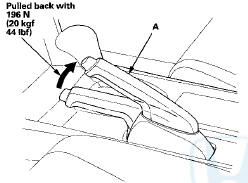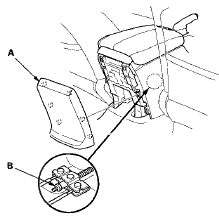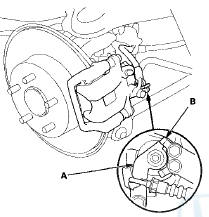 Honda Accord: Parking Brake Inspection and Adjustment
Honda Accord: Parking Brake Inspection and Adjustment
Inspection
1. Pull the parking brake lever (A) with 196 N (20 kgf, 44 Ibf) of force to fully apply the parking brake.
The parking brake lever should be locked within the specified number of clicks.
Lever locked clicks: 7 to 9 clicks

2. If the number of lever clicks is not as specified, adjust the parking brake.
Adjustment
1. Release the parking brake lever fully.
2. Pull out the center console rear trim (A) (see page 20-160).

3. Loosen the parking brake adjusting nut (B).
4. Raise and support the vehicle (see page 1-13).
5. Remove the rear wheels.
6. Make sure the lever (A) on the rear brake caliper contacts the arm (B).
NOTE. The lever will contact the arm when the parking brake adjusting nut is loosened.

7. Clean the mating surfaces between the brake disc and the inside of the wheel, then install the rear wheels.
8. Pull the parking brake lever 1 click.
9. Tighten the parking brake adjusting nut until the parking brakes drag slightly when the rear wheels are turned.
10. Release the parking brake lever fully, and check that the parking brakes do not drag when the rear wheels are turned. Readjust if necessary.
11. Make sure the parking brake lever is within the specified number of clicks (7 to 9 clicks).
12. Install the center console rear trim (see page 20-160).
 Brake Pedal and Brake Pedal Position Switch
Adjustment
Brake Pedal and Brake Pedal Position Switch
Adjustment
Pedal Height
1. Turn t h e brake p e d a l p o s i t i o n switch 45В°
counterclockwise, and pull it back until it is no longer
touching the brake pedal.
2. Remove the footrest (see step 4 on ...
 Brake System Bleeding
Brake System Bleeding
NOTE:
- Do not reuse the drained fluid. Use only new Honda
DOT 3 Brake Fluid from an unopened container. Using
a non-Honda brake fluid can cause corrosion and
shorten the life of the system.
- ...
See also:
Rear Seat Armrest Replacement
Special Tools Required
KTC Trim Tool Set SOJATP2014*
*Available through the Honda Tool and
Equipment
Program; call 888-424-6857
4-door
NOTE:
- Use the appropriate tool from the KTC trim tool s ...
Voice Control Operation
Your vehicle has a voice control system that allows hands-free operation of
most of
the navigation system functions.
The voice control system uses the
(Talk) and (hang-up/back) buttons
on ...
Front Grille Replacement
Special Tools Required
KTC Trim Tool Set SOJATP2014*
* Available through the Honda Tool and
Equipment
Program; call 888-424-6857
Grille Replacement - 2-door
NOTE:
- Take care not to scratch th ...
